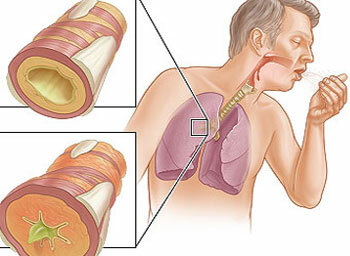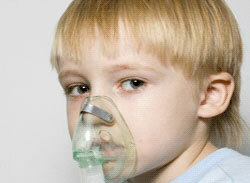The actual prevalence of asthma in the world is quite high - more than 5%.Studies conducted in large cities of Russia reveal the presence of symptoms of this disease in 5-7% of the population.
Untimely detection and later treatment of bronchial asthma leads to an increase in the incidence of bronchoconstriction, a decrease in the quality of life of a person, increases the likelihood of disability and shortens life expectancy.
It is important to seek medical help in a timely manner. Modern allergology has a wide arsenal of tools and methods for treating this pathology.
Contents of
- 1 Bronchial Asthma - What is it?
- 2 Causes of bronchial asthma
- 3 Symptoms of bronchial asthma in stages of development
- 4 Treatment of bronchial asthma
- 5 Prevention of bronchial asthma
- 6 Bronchial asthma, ICD code 10
Bronchial asthma - What is it?

From the Greek language the word "asthma" is translated as "heavy breathing, shortness of breath".In bronchial asthma in the respiratory tract, under the influence of a large number of factors, the process of inflammation develops.
It becomes chronic and is not associated with microbial flora( aseptic inflammation as a result of impaired immune system performance).Clinically, this leads to the emergence of episodes of bronchial obstruction - a temporary narrowing of the lumen of the bronchi of different degrees of severity.
Bronchial obstruction causes a disturbance of respiratory function in the form of difficulty exhalation, accompanied by coughing, shortness of breath, wheezing.
Characteristic of the night appearance( an important diagnostic feature).
At the onset of the disease, breathing disorder can be resolved spontaneously, but medication is often required. Patients suffering from bronchial asthma, they should always be at hand( in the first aid kit).
Causes of bronchial asthma
Factors that form chronic inflammation in the airways are called inducers and are divided into internal and external. Such classification is necessary for their effective elimination during treatment.
1. Internal:
- Genetic predisposition is a probability of getting sick, having a relative with asthma 35 - 70%;
- Allergic reaction is an excessive reactivity of the body, which develops when a variety of substances called allergens enter the bloodstream. In patients with bronchial asthma, there is an unfavorable genetic background of the immune system. Clinically, this is expressed in severe narrowing of the respiratory tract by inhalation of allergic agents;
- Hyperreactivity - increased bronchial response to irritation and inflammation, which leads to a strong narrowing of their lumen;
- Polo-age features. So, up to 10 years, boys are more often sick among children, in transition and adulthood, the disease is more often detected in women;
- Obesity. Currently, this metabolic disorder is regarded as an endocrine disease, becauseit is always accompanied by hormonal disorders. And they, in turn, create a background for the inadequate response of the immune system.
2. External( environmental factors):
- Substances that cause a reaction in the bronchi. Most often these are respiratory allergens: house dust mites, animal wool, mold and yeast fungi, allergens cockroaches, etc.;
- Tobacco smoke, incl.and its passive inhalation, vehicle exhaust( therefore in cities the prevalence of asthma is higher than in rural areas);
- Occupational hazards, such as inhalation of dust, acid vapors, cold or hot air;
- Viruses. Children have a common cause, provoking asthma - a respiratory syncytial virus infection. These microbial agents alter local immunity in the bronchi, provoking an increased allergic mood;
- Increased susceptibility to ozone, nitrogen dioxide and sulfur;
- The predominant use of highly processed foods in combination with low in the diet of fruits and vegetables. So, in most such "harmful" products contain preservatives, stabilizers, animal fats of poor quality, negatively affecting immunity.
Symptoms of bronchial asthma in stages of development of

1. Stage of predisposition or biological defects
Has no special manifestations and is clinically a latent, internal stage that is characterized by the presence or influence on human asthma inducers described above.
At this stage, the development of the disease can be prevented if in time to conduct laboratory diagnosis and identify internal biological defects that indicate the possibility of developing asthma.
For example, in people with hyperreactivity of the bronchi at this stage, a large number of eosinophils( leukocytes) are detected in flushes from the bronchial mucosa and sputum.
Further identification of the most likely allergens and their elimination by specific antiallergic methods and lifestyle changes is required.
2. Stage of
delivery There are no typical clinical manifestations yet, but the risk factors that affect a person already trigger a mechanism that changes the normal functioning of the respiratory tract.
A person may become respiratory, there is obstructive bronchitis( broken bronchial patency), cases of difficulty breathing are recorded, an allergic reaction occurs in the form of a cold, edema, urticaria.
In the blood test, even at this stage, an increase in eosinophils may be detected.
The measures taken to identify the causes leading to a respiratory system disorder and eliminate( if possible) the risk factors for bronchial asthma, reduce the likelihood of further progression of the changes that form the disease.
3. Stage of clinically pronounced asthma
 Symptoms appear typical for bronchial asthma, and treatment should be carried out in full. It is also necessary to minimize the influence of inductor factors.
Symptoms appear typical for bronchial asthma, and treatment should be carried out in full. It is also necessary to minimize the influence of inductor factors.
Severity of symptoms depends on the severity of the disease, the extent of the influence of risk factors and triggering factors( triggers).Triggers are all respiratory allergens, specific for a particular person, paint, aerosols, emotional stress, physical activity, SARS, non-steroidal anti-inflammatory drugs, beta-blockers.
The severity of bronchial asthma is determined by the frequency of coughing and shortness of breath, as well as the need to use and the amount of doses of the drugs used, after which the condition improves( whether the use of hormones is required, how often bronchodilators of short action are used).
Asthma of mild degree is manifested by coughing attacks, which occur sporadically( with the action of inducers and amplified under the influence of triggers).
Patients with fatigue, decreased activity, worsened tolerability of physical activity. Cough associated with such signs of an allergic condition, like nasal congestion or runny nose, lachrymation, sneezing.
Distinctive features of these conditions is the mucous nature of pathological secrets. If the cause is bacterial agents, the secret becomes purulent.
Asthma of moderate to severe has persistent symptoms.
The cough is accompanied by difficulty breathing, which can build up before the attack of suffocation. Asthma is characterized by difficulty in exhaling, not inhaling! This is the main sign of bronchial obstruction.
Dry wheezing, shortness of breath appear. In severe course, respiratory failure occurs. It manifests itself in an increase in the size of the chest in the form of bloating, cyanosis of the skin, increased heart rate, difficulty in talking.
Reference diagnostic criteria for detecting bronchial asthma:
- Recurring episodes of wheezing that can be heard from a distance;
- Excruciating night cough;
- Chryps and cough always appear under the influence of the same factors - dust, smells, wool, aerosols, medication, etc.(as a result of the action of the causative allergen);
- Cold and STI protracted nature( more than 10 days).These conditions always lead to bronchitis;
- Relief is brought only by anti-asthmatic drugs( hormonal or non-hormonal depending on the severity of the disease).
Treatment of bronchial asthma
 Therapy of this disease is always lengthy and complex, with a complete cure mono achieved only in childhood, if the time to take the necessary measures. In adulthood, therapy is aimed only at preventing seizures and preventing the progression of the disease.
Therapy of this disease is always lengthy and complex, with a complete cure mono achieved only in childhood, if the time to take the necessary measures. In adulthood, therapy is aimed only at preventing seizures and preventing the progression of the disease.
Treatment of bronchial asthma in adults should be combined with a 100% cessation of smoking. All patients need to take care of preventing contact with allergens and provoking factors.
It is necessary to establish, so-called, "hypoallergenic life" - to eliminate all sources of dust and other allergens. These are carpets, draped curtains, soft toys, pillows with fluff, open book shelves, home flowers, etc.
It is recommended to clean old things, furniture, which is a favorite habitat for house dust mites. It is desirable that the material of the walls allowed to conduct their wet cleaning.
It is important to follow a hypoallergenic diet that excludes both products that are allergic to, and refined, fatty, canned products and everything sweet. It is necessary to give preference to natural food.
In bronchial asthma, pharmacological treatment means the following directions:
1. Elimination of attack

Use of bronchodilators salbutamol, terbutaline, fenoterol( B 2 - short-acting agonists).Their action consists in the rapid expansion of the bronchi and the elimination of difficulty breathing and suffocation.
Apply them usually independently in the form of aerosols, and in case of inpatient treatment - through the nebulizer. These are emergency drugs.
- first aid for an asthma attack
2. Treatment of an exacerbation
During an exacerbation, drugs that eliminate inflammation are used. The most effective are hormones - inhaled glucocorticoids.
These include beclomethasone, fluticasone, budesonide, less often flunisolide and triamcinolone. In severe cases, systemic glucocorticoids, such as prednisolone, are used.
The strategy of treating bronchial asthma in case of an exacerbation consists in applying two approaches: "step up" or "step down", which are both stepped.
With the approach " step up ", or " from the bottom up ", a small dose of the drug is first assigned and it rises to the first signs of clinical improvement. In the absence of effect, the drug is replaced by a stronger one.
With the approach " step down ", or " from top to bottom ", the initial dose of the used anti-inflammatory drug is maximum. Once a positive effect is achieved, the dose is reduced to a minimum, which provides a steady improvement.
This approach quickly eliminates manifestations of exacerbation of bronchial asthma, shortens the time and cost of treatment. Therefore, it is preferable.
3. Basic therapy, preventing exacerbation
Consists in the constant use of anti-inflammatory drugs in a small, maintenance dose. The following series of drugs are used:
- Hormones-glucocorticoid systemic or inhalation;
- Long-acting bronchodilators( B 2 -agonists of long-acting( salmeterol, formoterol), long-acting theophyllines;
- Stabilizers of cell membranes( cromoglycate, nedocromil)
- Modulators of leukotrienes( zafirlukast, montelukast, zileuton)
The most effective combination for the control of bronchial asthmais a combination of a corticosteroid with inhalation by administration and long-acting B 2 -agonists, for example, fluconazole + salmeterol
This combination is possible when using two ingbut in practice, combined drugs, for example "Seretide Multidisk", have a greater effect and convenience
4. Treatment of asthmatic status of - a severe attack that is not eliminated by usual medications for a patient
Such urgent therapy implies a set of therapeutic measures inHormones with intravenous route of administration, bronchodilators through nebulizer, mask oxygen, IVL, antibiotics.
Additional treatment methods are aimed at general strengthening of the body. Therefore, recommended: a complex of therapeutic physical training, respiratory gymnastics, su-dzhok, sanatorium-resort mountain-climatic treatment, halochamber, UFO blood, phytotherapy.
An important role is played by teaching patients the right way of life. For this purpose, special "schools of bronchial asthma" have been created. They also tell how to provide emergency assistance on their own.
Prevention of bronchial asthma
Primary prevention of is the prevention of the formation of an allergic predisposition in a child in the prenatal and postnatal periods.
It consists of the following activities:
- elimination of exposure to allergens and smoking pregnant( including passive);
- breastfeeding for at least 6 months( it contributes to the proper formation of the immune system of the child);
- limiting the exposure of allergens to children at high risk of developing allergies in the first years of life.
Secondary prophylaxis of is the removal of contact with the allergen. It can be carried out only when establishing its appearance and the occurrence of an allergic reaction for the first time( the stage of sensitization).
Tertiary prevention - implies the prevention of complications of bronchial asthma. The activities of this stage are realized by timely detection and proper treatment of the disease.
Bronchial asthma, ICD code 10
In the International Classification of Diseases of the 10th revision of the ICD 10, bronchial asthma is( the full path to the code):
Class X. Respiratory diseases( J00-J99)
J40-J47 - Chronic lower respiratory disease
Code J45 - Asthma
- J45.0 Asthma with predominance of the allergic component
- J45.1 Non-allergic asthma
- J45.8 Mixed asthma
- J45.9 Asthma, unspecified



